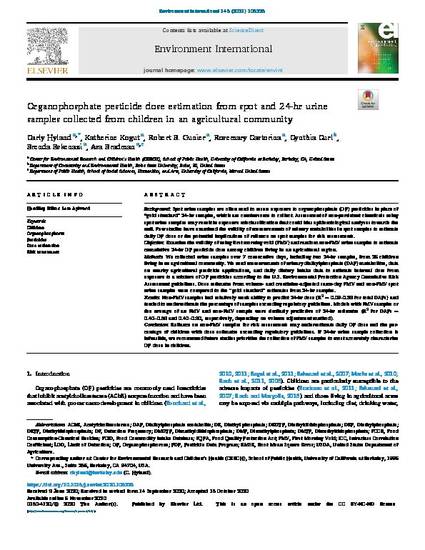
Background: Spot urine samples are often used to assess exposure to organophosphate (OP) pesticides in place of “gold standard” 24-hr samples, which are cumbersome to collect. Assessment of non-persistent chemicals using spot urine samples may result in exposure misclassification that could bias epidemiological analyses towards the null. Few studies have examined the validity of measurements of urinary metabolites in spot samples to estimate daily OP dose or the potential implications of reliance on spot samples for risk assessments.
Objective: Examine the validity of using first morning void (FMV) and random non-FMV urine samples to estimate cumulative 24-hr OP pesticide dose among children living in an agricultural region.
Methods: We collected urine samples over 7 consecutive days, including two 24-hr samples, from 25 children living in an agricultural community. We used measurements of urinary dialkylphosphate (DAP) metabolites, data on nearby agricultural pesticide applications, and daily dietary intake data to estimate internal dose from exposure to a mixture of OP pesticides according to the U.S. Environmental Protection Agency Cumulative Risk Assessment guidelines. Dose estimates from volume- and creatinine-adjusted same-day FMV and non-FMV spot urine samples were compared to the “gold standard” estimates from 24-hr samples.
Results: Non-FMV samples had relatively weak ability to predict 24-hr dose (R2 = 0.09–0.38 for total DAPs) and tended to underestimate the percentage of samples exceeding regulatory guidelines. Models with FMV samples or the average of an FMV and non-FMV sample were similarly predictive of 24-hr estimates (R2 for DAPs = 0.40–0.68 and 0.40–0.80, respectively, depending on volume adjustment method).
Conclusion: Reliance on non-FMV samples for risk assessments may underestimate daily OP dose and the percentage of children with dose estimates exceeding regulatory guidelines. If 24-hr urine sample collection is infeasible, we recommend future studies prioritize the collection of FMV samples to most accurately characterize OP dose in children.
